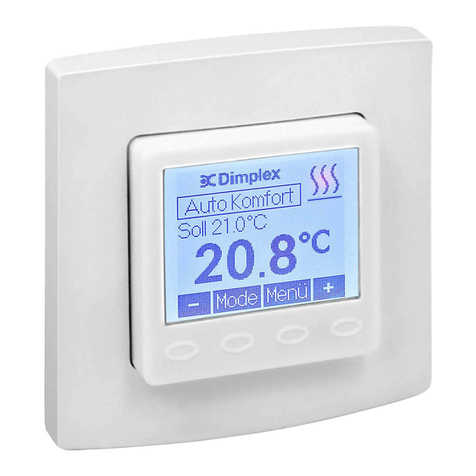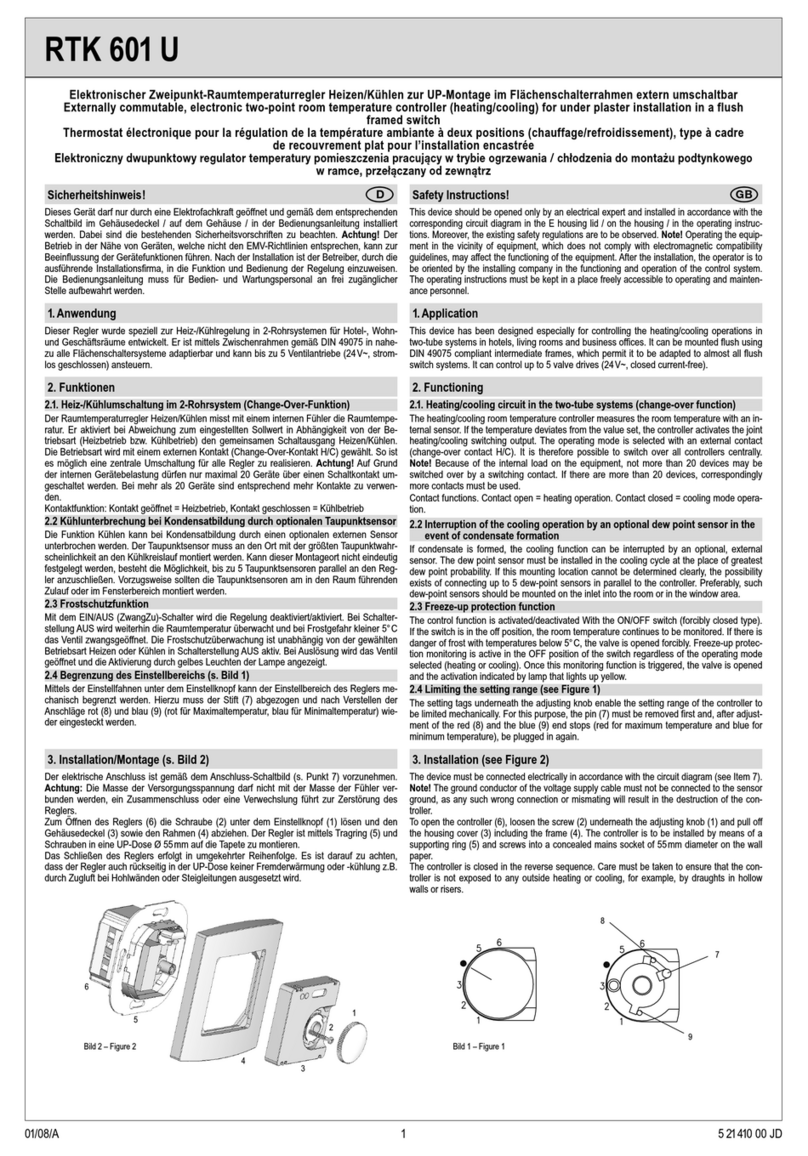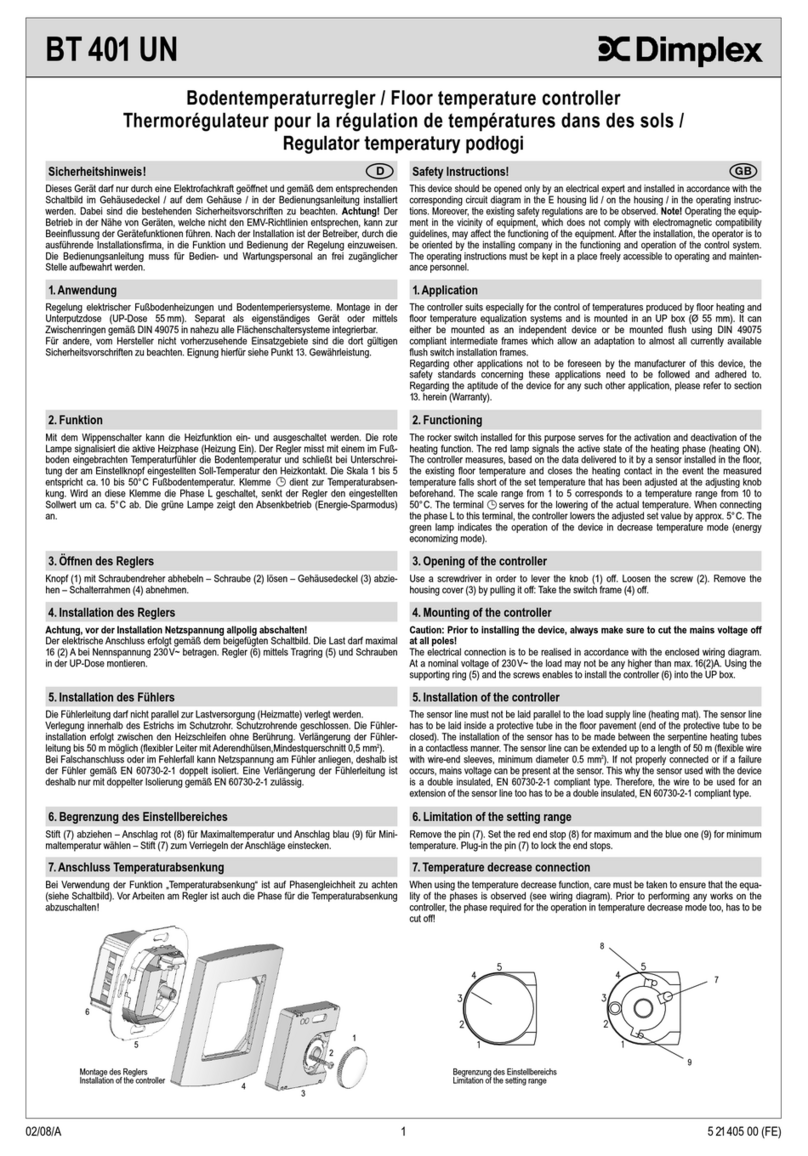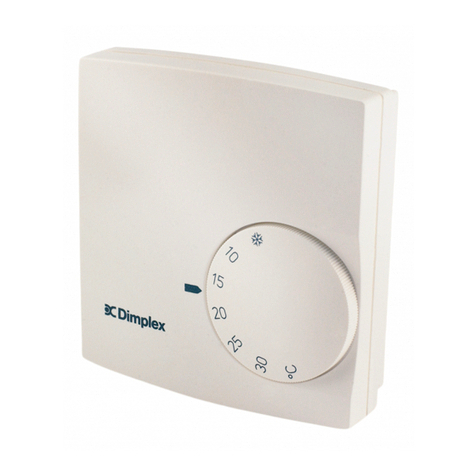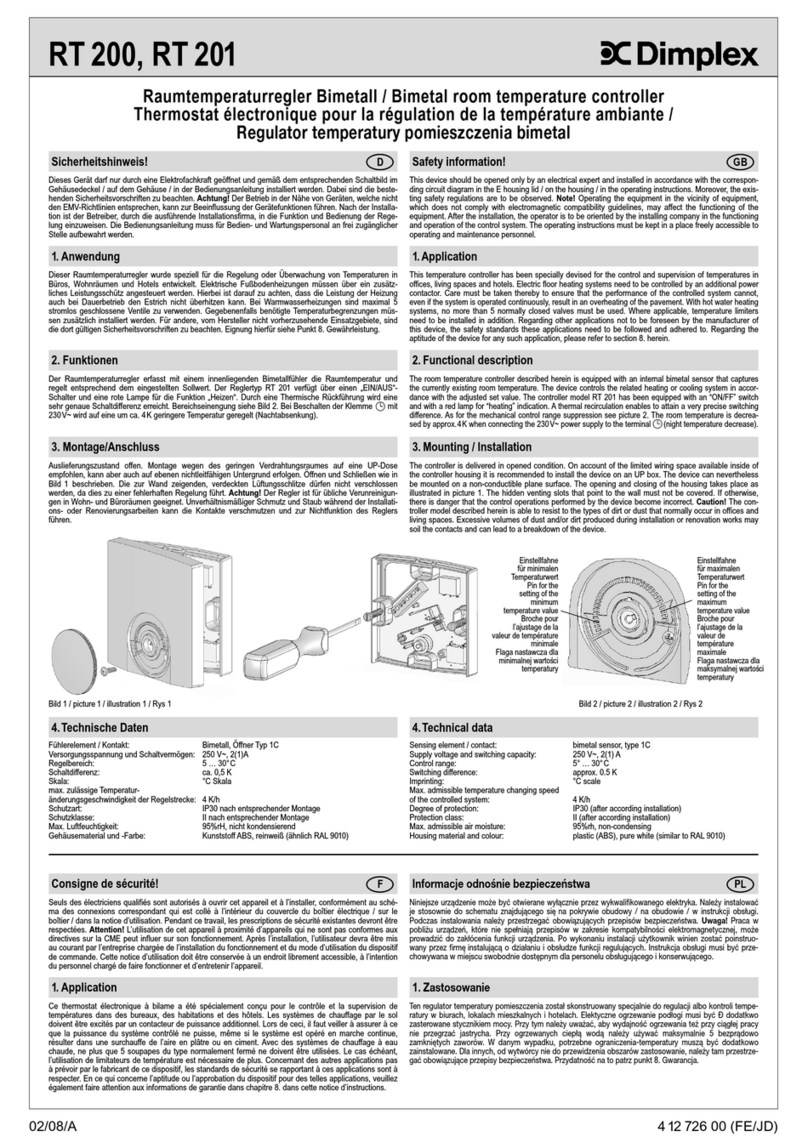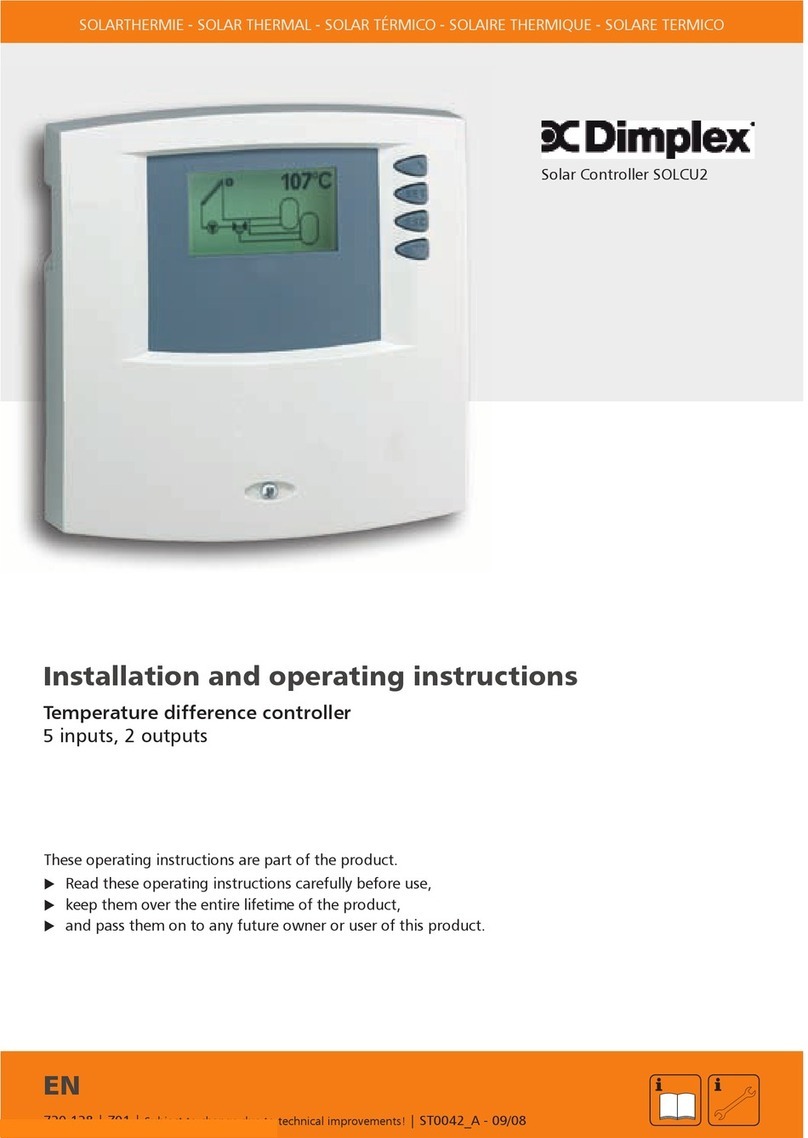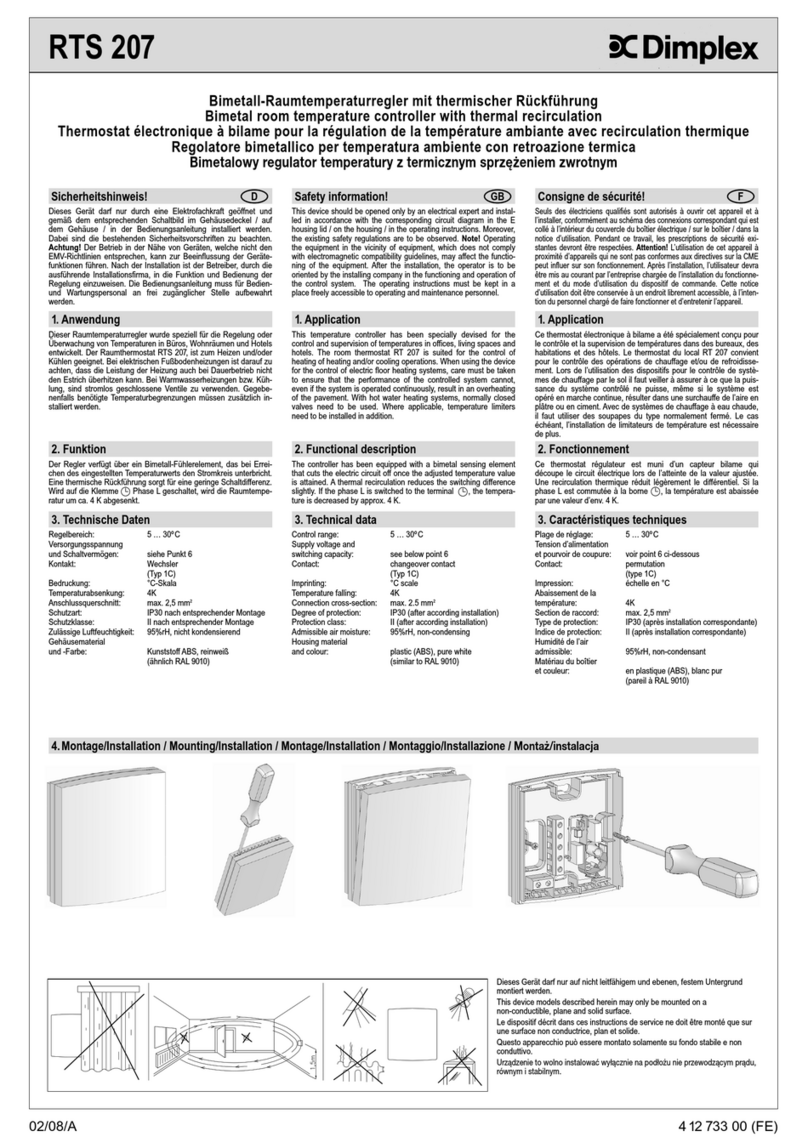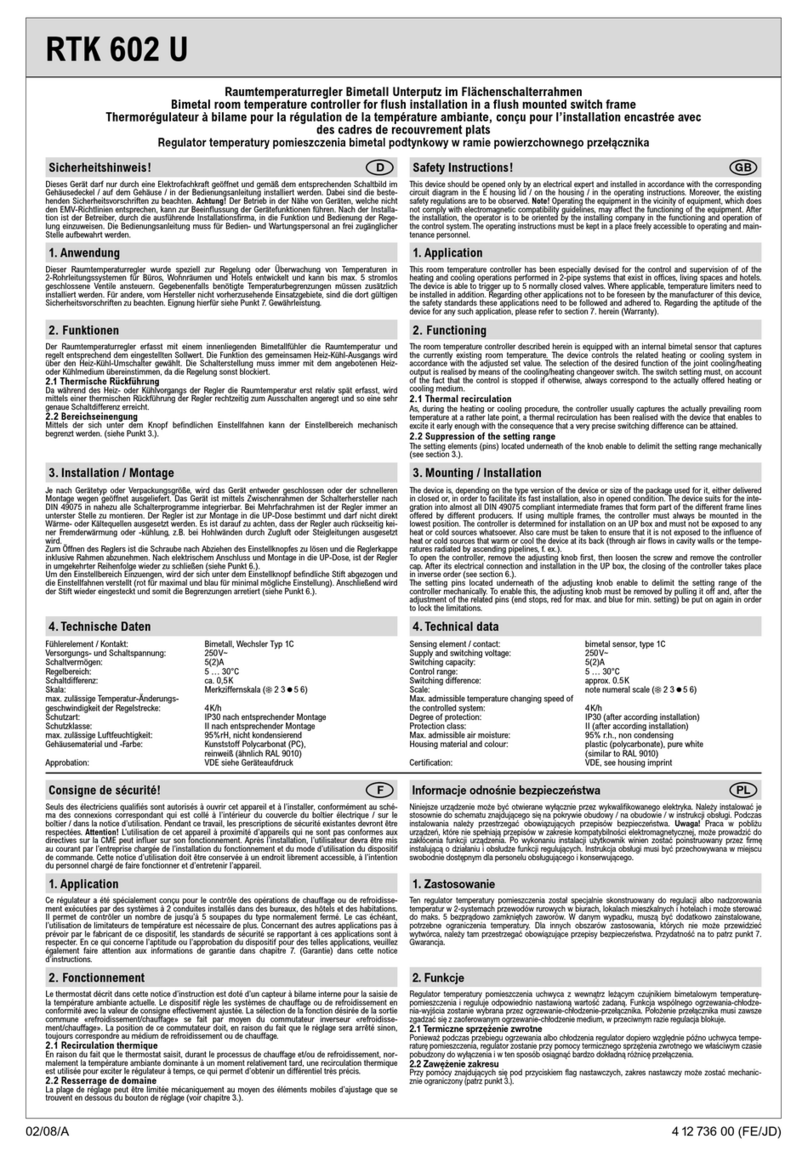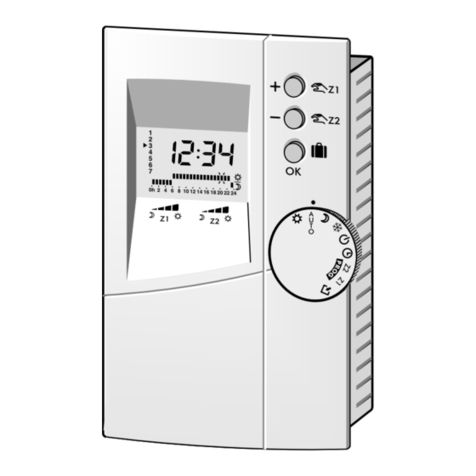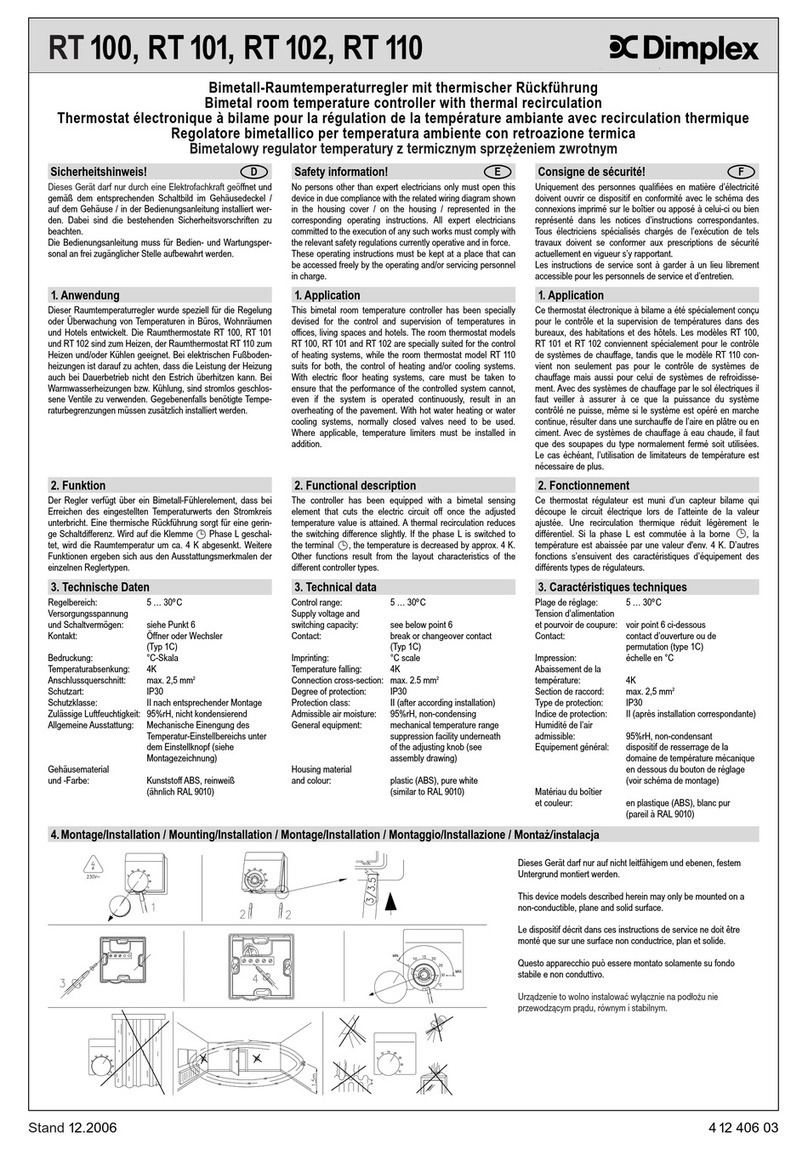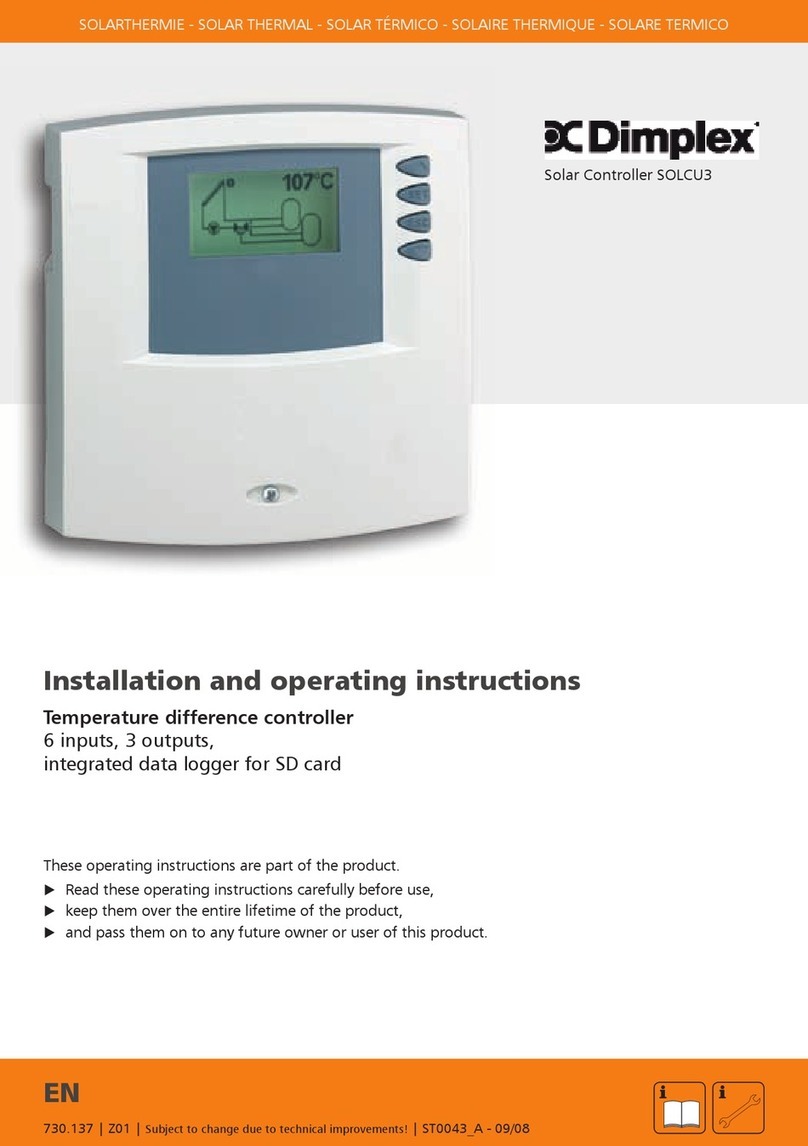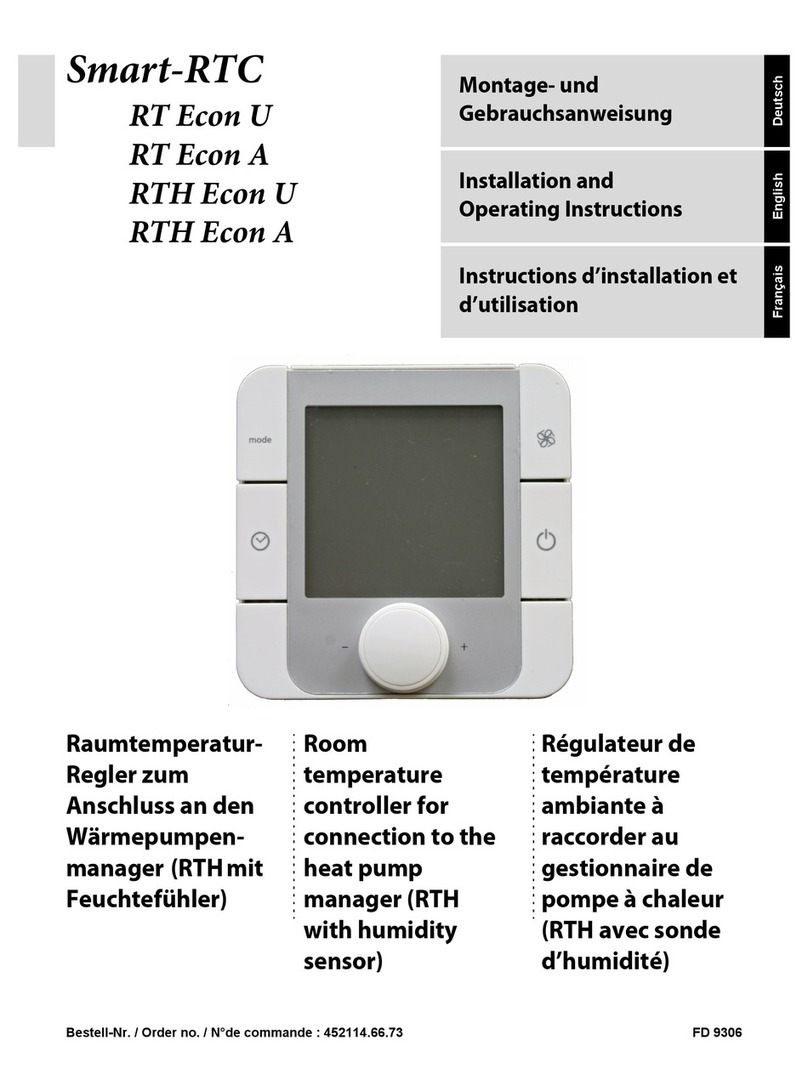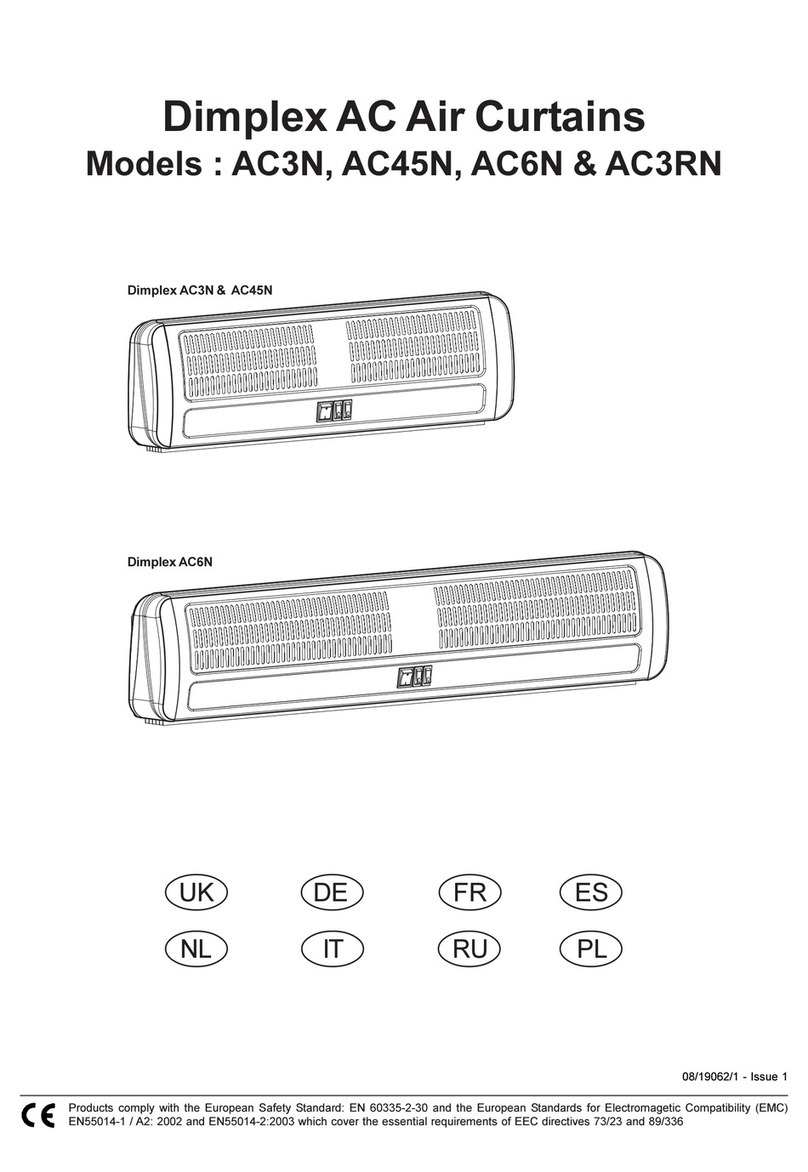3
Consignes de sécurité!
Seuls des électriciens qualifiés sont autorisés à ouvrir cet appareil et à l’installer, conformément au schéma
des connexions correspondant qui est collé à l’intérieur du couvercle du boîtier électrique / sur le boîtier /
dans la notice d’utilisation. Pendant ce travail, les prescriptions de sécurité existantes devront être respec-
tées. Attention! L’utilisation de cet appareil à proximité d’appareils qui ne sont pas conformes aux direc-
tives sur la CME peut influer sur son fonctionnement. Après l’installation, l’utilisateur devra être mis au
courant par l’entreprise chargée de l’installation du fonctionnement et du mode d’utilisation du dispositif de
commande. Cette notice d’utilisation doit être conservée à un endroit librement accessible, à l’intention du
personnel chargé de faire fonctionner et d’entretenir l’appareil.
Uwagi doatyczące bezpieczeństwa!
Niniejsze urządzenie może być otwierane wyłącznie przez wykwalifikowanego elektryka. Należy instalować
je stosownie do schematu znajdującego sie˛ na pokrywie obudowy / na obudowie / w instrukcji obsługi.
Podczas instalowania należy przestrzegać obowiązujących przepisów bezpieczeństwa. Uwaga! Praca w
pobliżu urządzeń, które nie spełniają przepisów w zakresie kompatybilności elektromagnetycznej, może
prowadzić do zakłócenia funkcji urządzenia. Po wykonaniu instalacji użytkownik winien zostać poinstruo-
wany przez firme˛ instalującą o działaniu i obsłudze funkcji regulujących. Instrukcja obsługi musi być prze-
chowywana w miejscu swobodnie dostępnym dla personelu obsługującego i konserwującego.
FPL
1. Application
Ce régulateur convient spécialement pour des applications sur le plan de la technique du bâtiment. Il a été
conçu pour le contrôle de températures produites par de systèmes sol chauffants électriques et de systè-
mes pour la mise en équilibre de la température du plancher en fonction de la température effective du
plancher. Le dispositif est installé dans une boîte de branchement encastrée (Ø 55 mm). Il peut être
monté soit en tant que dispositif indépendant ou peut, lors de l’utilisation des cadres intermédiaires en
conformité avec DIN 49075, être intégré dans presque tous les systèmes de cadres de recouvrement
actuellement en vente. Concernant des autres applications pas à prévoir par le fabricant de ce dispositif,
les standards de sécurité se rapportant à ces applications sont à respecter. En ce qui concerne l’aptitude
ou l’approbation du dispositif pour des telles applications, veuillez également faire attention aux informati-
ons de garantie dans chapitre 17. (Garantie) dans cette notice d’instructions.
1. Zastosowanie
W technice domowej do nadzorownia podłogi regulatora temperatury pomieszczenia elektrycznego ogrze-
wania podłogi i sytemów temperowania podłogi w zamontowanej up-(podtynkowej) puszce. Jest jako
samodzielny przyrząd dający się zastosować albo przy pomocy pierścieni oddzielających według DIN
49075 w prawie wszystkich systemach zaadoptowanych płaskich przełącznikach.
Dla innych, od producenta nie do przewidzenia obszarów zastosowania, musi sie˛ tam przestrzegać
obowiązujących przepisów bezpieczeństwa. Przydatność na to patrz punkt 17. Gwarancja.
2. Fonctionnement
Le régulateur mesure, sur la base des données délivrées par un détecteur interne la température ambiante
existante et utilise les données saisies par un détecteur externe pour la surveillance de la température du
plancher. Tant que la température du plancher maximalement admissible n’est pas dépassée, le contact de
chauffage est fermé lorsque la température effectivement mesurée sous-dépasse la température de consi-
gne ambiante préalablement ajustée. La gamme au bouton de réglage allant de à 5 correspond à une
gamme de température de 5 à 30°C. La lampe-témoin rouge prévue à cet effet sert pour l’indication de l’état
actif de la phase de chauffage. La fonction de chauffage peut être désactivée par moyen de l’interrupteur.
2. Funkcja
Regulator mierzy z wewne˛trznym czujnikiem temperature˛ pomieszczenia i nadzorowuje z zewne˛trzym czuj-
nikiem temperature˛ podłogi. Dopóki maksymalna temperatura podłogi nie zostanie przekroczona, zostanie
zamknie˛ty przy przekroczeniu na dół wartości zadanej temperatury pomieszczenia, kontakt ogrzewacza.
Skala …6 odpowiada ca. 5 …30°C temperaturze pomieszczenia. Czerwona lampka sygnalizuje
aktywną faze˛ ogrzewania (ogrzewanie włączone). Przełącznikiem może zostać wyłączona funkcja ogrzewa-
nia.
3. Ouverture du régulateur
Soulever le bouton (1) à l’aide d’un tournevis et l’enlever. Ensuite desserrer la vis (2) et ôter le couvercle
du boîtier (3) en tirant. Après ceci, enlever le cadre de recouvrement (4).
3. Otwarcie regulatora
Przycisk (1) podnieść śrubociągiem Đ śrube˛ (2) poluzować Đ pokrywe˛ obudowy Đ (3) odciągnąć Đ rame˛Đ
przełączników (4) zdjąć.
4. Installation du régulateur
Le raccordement électrique est à réaliser en conformité avec le schéma de branchement inclus (illustration1)
en utilisant les bornes à vis prévues à cet effet. La section du conducteur solide à utiliser dépend de la char-
ge actuelle et doit, selon le cas, avoir une taille de 1,5 à 2,5 mm2. La section de la ligne du détecteur fait 0,5
mm2. Aucun conducteur de terre n’est utilisé. L’installation du régulateur (6) dans la boîte encastrée se fait
par moyen du collier support (5) et des vis fournies avec l’appareil. Les travaux d’installation une fois
terminés, il faut faire attention à utiliser le potentiomètre prévu à cet effet (illustration 2) afin d’ajuster le régu-
lateur à la charge effectivement connectée (voir chapitre14., «Ajustage à la charge connectée»).
4. Instalacja regulatora
Elektryczne przyłącze zamontować według „przyłącza-planu połączeń
“
(Rysunek 1) z zaciskami śrubowymi
Đ masywnym przewodem przekroju zależnego od 1,5 …2,5 mm2, przekrój przewodu czujnika 0,5 mm2Đ
żaden przewód ochronny Đ regulator (6) przy pomocy pierściena nośnego (5) i śrub w up-(podtynkowej)
puszce na tapecie. Po instalacji regulator musi zostać dopasowany przy pomocy potencjometra (Rysunek 2)
do przyłączonego obciążenia (porów. punkt 14. „Nastawienie obciążenia
“
).
5. Installation du détecteur pour la surveillance de la température
La ligne du détecteur doit, après son insertion dans un tube protecteur, être posée dans le mur ou dans l’aire en
plâtre ou en ciment. L’installation du détecteur dans le tube protecteur est à faire entre les serpentins réchauf-
feur de telle manière qu’il ne les touche pas. La pose en parallèle avec des câbles de réseau est interdite. La
ligne du détecteur peut être prolongée jusqu’à une longueur de 50m (fil flexible avec des embouts, section mini-
male 0,5 mm
2
). Attention! Le détecteur peut, lors de l’apparition d’une panne ou d’un défaut, être sous
potentiel de tension de réseau! C’est pourquoi le détecteur ainsi que le câble requis pour la prolongation de la
ligne du détecteur doivent être des types à double isolation en conformité avec la norme EN 60730-2-1!
5. Instalacja nadzoru czujnika
Wewnątrz ściany i jastrycha rurze ochronnej; Đ pe˛tlami ogrzewczymi bez styczności; Đ rozłożenie równ-
oległe z kablem sieciowym niedopuszczalne; Đ przedłużenie do 50 m z 0,5 mm2(elastyczne przewody z
końcówkami pochewek żył); przy błe˛dnym połączeniu albo w przypadku błędu może przylegać na czuj-
niku napięcie sieci, dlatego jest podwójna izolacja według EN 60730-2-1 nakazana!
6. Raccordement du dispositif
7. Limitation de l’étendue de réglage
8. Fonction d’abaissement de la température nocturne
Le raccordement de L à la borne résulte dans l’activation de la fonction d’abaissement de la tempéra-
ture nocturne. Ceci peut, par exemple, être réalisé par une minuterie externe ou par un régulateur piloté
par une horloge. La lampe-témoin verte sert pour l’indication de l’état actif de la fonction d’abaissement de
la température nocturne. (Attention! Deuxième alimentation d’arrivée!). Avant tous travaux au régula-
teur, la fonction d’abaissement de la température nocturne aussi est à débrancher en tout cas!
7. Ograniczenie zakresu nastawiania
8. Funkcja obniżenie nocne
Zostanie na zacisku przyłączeniowym L przyłączony, to obniżenie nocne jest aktywne. To może np.
zostać zrealizowane przez zewne˛trzny zegar sterujący albo regulator zegarów. Zielona lampka pokazuje
aktywne obniżenie nocne. Uwaga! Drugie zasilanie) Đ przy pracach na regulatorze należy też obniżenie
nocne wyłączyć!
9.Caractéristiques techniques
Tension de service: 230V / 50Hz
Plage de réglage: 5 … 30°C (gamme … 6)
Limitation de la temp. du plancher: 20 … 60°C (gamme 2 … 6) (ajustable à l’intérieur)
Différentiel: env. 1K
Puissance absorbée: env.1W
Abaissement de la temp. nocturne: env. 4K (réglé fixe); branchement de à L
Contact: contact de fermeture, max. 230V 10(1.5)A
Détecteur interne: 47k
⏲
, NTC
Détecteur externe: 2k
⏲
, NTC selon DIN EN 44574-3,
(type à double isolation): DIN EN 50350 en conformité avec DIN EN 60730-2
Réaction en cas d’une défaillance
du détecteur: mise hors du circuit du chauffage
Indicateurs: Voyants DEL pour les indications «chauffage» et
«mode de service abaissement de la temp. nocturne»
Raccordement électrique: bornes à vis (0,5 … 2,5 mm2)
Montage: dans une boîte encastrée (Ø 55 mm)
Type de protection: IP30
Indice de protection: II (après installation correspondante)
Température ambiante: 0 … 40°C
Température de stockage: -20 … +70°C
Antiparasitage: en conformité avec EN 50081-1 et EN 50082-1
Napięcie sieciowe: 230V / 50Hz
Zakres regulacji: 5
…
30
°
C (skala
…
6)
Ograniczenie temperatury podłogi: 20
…
60
°
C (skala 2
…
6) (wewnątrz nastawialna)
Różnica przełączania: ca. 1K
Pobór mocy: ca. 1W
Obniżenie nocne: ca. 4K stałe; przyłącze na L
Kontakt: normalnie otwarty, max. 230V 10(1,5)A
Wewne˛trzny czujnik: 47k
⏲
, NTC
Zewne˛trzny czujnik (podwójnie izolowany): 2k
⏲
, NTC odpow. DIN EN 44574-3,
DIN EN 50350 odpow. DIN EN 60730-2
Rozpoznanie uszkodzenia czujnika: Ogrzewanie zostanie wyłączone
Wyświetlać: LED dla ogrzewania, obniżenie nocne
Przyłącza śrubowe: 0,5
…
2,5 mm2
Umocowanie: w UP-puszce (
Ø
55 mm)
Rodzaj ochrony IP30
Klasa ochrony: II (po odpowiednim montażu)
Temperatura otoczenia: 0
…
40
°
C
Temperatura składowania: -20
…
+70
°
C
Zakłócenie iskrowe: według EN 50081-1 i EN 50082-1
9. Techniczne dane
Pour refermer le régulateur, suivre les pas expliqués dans chapitre 3. ci-dessus en ordre inverse.
10.Accessoires
Le régulateur est fourni avec une sonde à douille correspondante (4 m).
10. Osprze˛t
Regulator zostanie dostarczony z 4 m osłonki czujnika.
7
8
9
7
8
9
D’abord enlever la goupille (7). Ensuite mettre la butée (8) pour l’ajustage de température maximale et la
butée bleue (9) pour celui de la température minimale. Après ceci, réenficher la goupille (7) pour arrêter
les deux butées.
6. Przyrząd zamknąć
Zamknie˛cie naste˛puje w odwrotnej kolejności do otwarcia.
Sztyft (7) ściągnąć Đ znak czerwony (8) dla maksymalnej temperatury a znak niebieski (9) dla minimalnej
temperatury wybrać Đ sztyft (7) do zablokowania końcowych znaków wetknąć.
1
2
3
4
5
6
1
2
3
4
5
6
